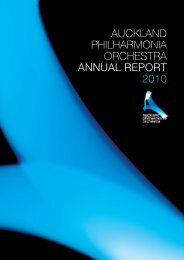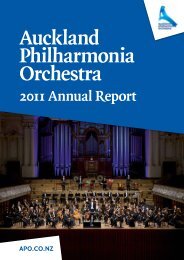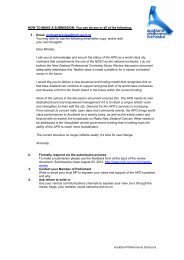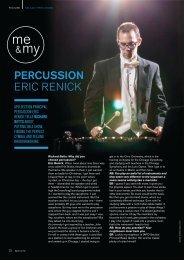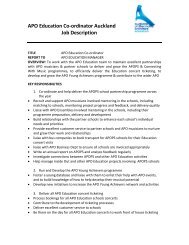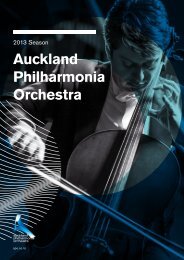Auckland Philharmonia Orchestra - the Auckland Philharmonia
Auckland Philharmonia Orchestra - the Auckland Philharmonia
Auckland Philharmonia Orchestra - the Auckland Philharmonia
You also want an ePaper? Increase the reach of your titles
YUMPU automatically turns print PDFs into web optimized ePapers that Google loves.
fur<strong>the</strong>r CORE funding <strong>the</strong> APO’s ability to respond to demand for this grass‐roots level ofengagement with <strong>the</strong> community is severely compromised.The depth of community support and connection can also be demonstrated by APO's new SistemaAotearoa programme that could only have been successfully implemented in Otara due to <strong>the</strong> factthat APO's Remix <strong>the</strong> <strong>Orchestra</strong> programme, Connecting With Music initiative and APOPS PartnershipSchool programme had already built relationships in this community. The <strong>Auckland</strong> <strong>Philharmonia</strong> isin <strong>Auckland</strong> all year, has multiple opportunities to offer contact for students and adult audiences,and has a tight feedback chain to hear what its public think of it.In <strong>the</strong> Fall 2011 edition of Symphony, <strong>the</strong> magazine of <strong>the</strong> League of American <strong>Orchestra</strong>s, Leaguepresident Jesse Rosen writes of an increasing need to serve a wide cross‐section of communities. Heargues that sustaining and growing this community need has never been more important. Thepresident of <strong>the</strong> Milwaukie Symphony says “Getting Community Engagement right will involveorchestras re‐thinking <strong>the</strong>mselves from top to bottom as cultural service agencies ra<strong>the</strong>r than highendentertainment companies.” 3<strong>Auckland</strong> <strong>Philharmonia</strong> <strong>Orchestra</strong> has understood this for years, and with <strong>the</strong> launch of APOConnecting in 2011, formalised this dimension of its offer as being core business.However, <strong>the</strong> issue here is that <strong>the</strong>re is demand for more of this outreach than APO can meet withcurrent hand‐to‐mouth resources of <strong>the</strong>se programmes, which run very lean.To expand <strong>the</strong> programme to meet current and projected demand would require increased corefunding on which <strong>the</strong> organisation can depend and with which it can plan with confidence.7 Playerrelated issues<strong>Auckland</strong> audiences expect, demand and deserve high standards from <strong>the</strong>ir resident orchestra. It isdifficult for APO to attract and retain players to meet this increasing demand for technical expertiseand mastery for several reasons, specifically:7.1 Earning levels and core fundingAPO is limited to paying players below <strong>the</strong> going rate for professional orchestras. Common practicefor paying wages of orchestra members is to use core funding for this core operating expense. TheAPO derives its core funding from two sources: <strong>Auckland</strong> Council (25%) and central government (viaCreative New Zealand) (24%). This totals 49% of APO's revenue. This is in stark contrast to o<strong>the</strong>r cityorchestras and to <strong>the</strong> New Zealand Symphony <strong>Orchestra</strong>, which enjoy a bedrock of funding supportand can remunerate (and programme) accordingly.The issue here is that APO receives relatively less core funding from central government than o<strong>the</strong>rcity symphony orchestras and <strong>the</strong>refore finds it harder to attract and retain top players.3 Symphony, Fall 2011, P17Contextualising <strong>Auckland</strong> and <strong>the</strong> NZ orchestral sector <strong>Auckland</strong> <strong>Philharmonia</strong> <strong>Orchestra</strong> Page 13



